Organizational Behavior: Enhancing Organizational Performance
VerifiedAdded on 2019/10/30
|9
|2008
|282
Essay
AI Summary
This essay provides a comprehensive overview of organizational behavior, exploring its significance in contemporary business environments. It delves into various theories, including cognitive dissonance, motivation (Herzberg's two-factor theory), and leadership, analyzing their impact on employee motivation, job satisfaction, and overall organizational performance. The essay offers a critical analysis of these theories, discussing how effective organizational behavior can lead to competitive advantages, increased knowledge sharing, and enhanced organizational commitment. It also addresses potential challenges such as diversity resistance and ethical considerations. The essay concludes with recommendations to improve organizational behavior, such as increasing employee engagement, implementing reward systems, and establishing effective leadership roles, ultimately emphasizing the importance of a positive work environment for organizational success.
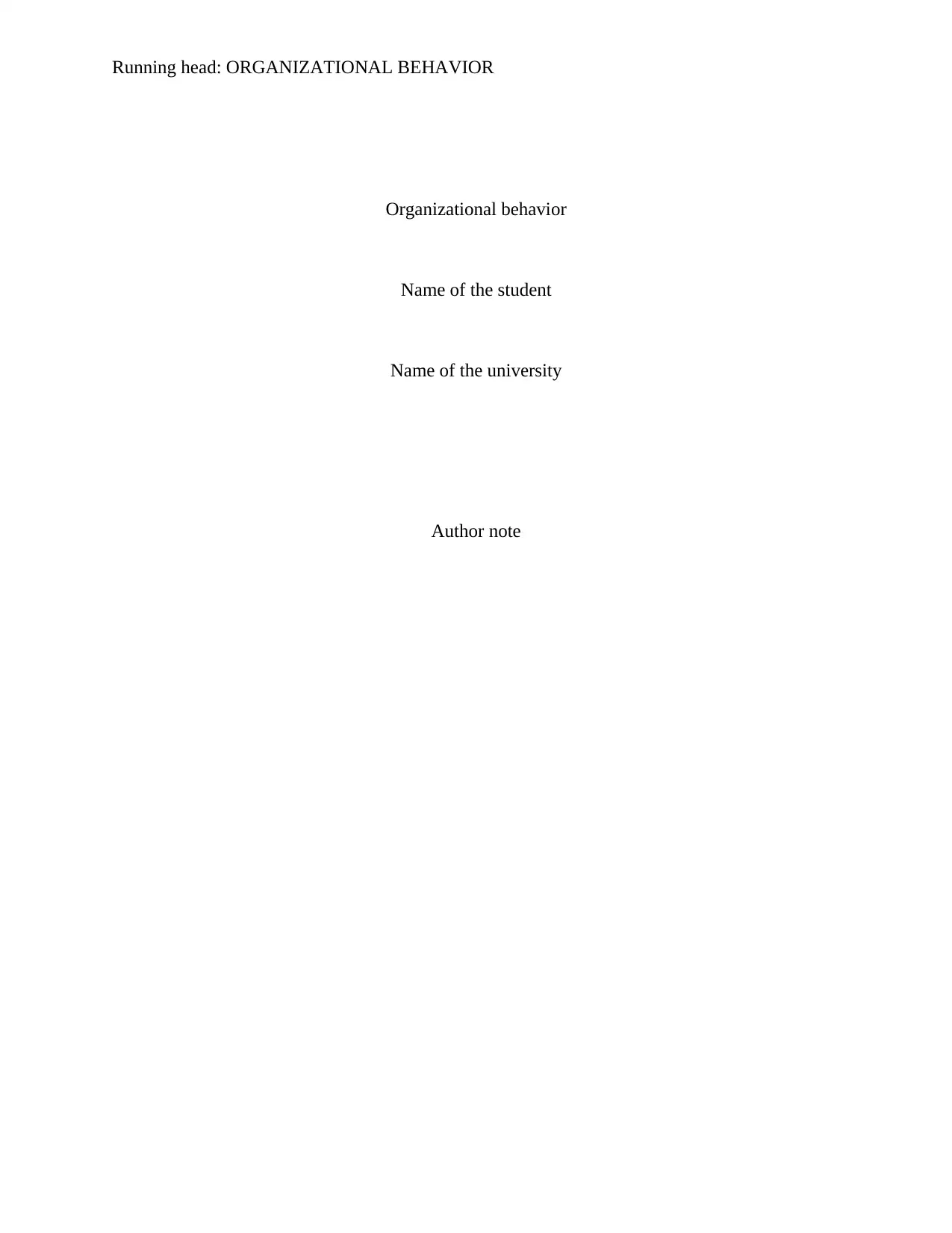
Running head: ORGANIZATIONAL BEHAVIOR
Organizational behavior
Name of the student
Name of the university
Author note
Organizational behavior
Name of the student
Name of the university
Author note
Paraphrase This Document
Need a fresh take? Get an instant paraphrase of this document with our AI Paraphraser
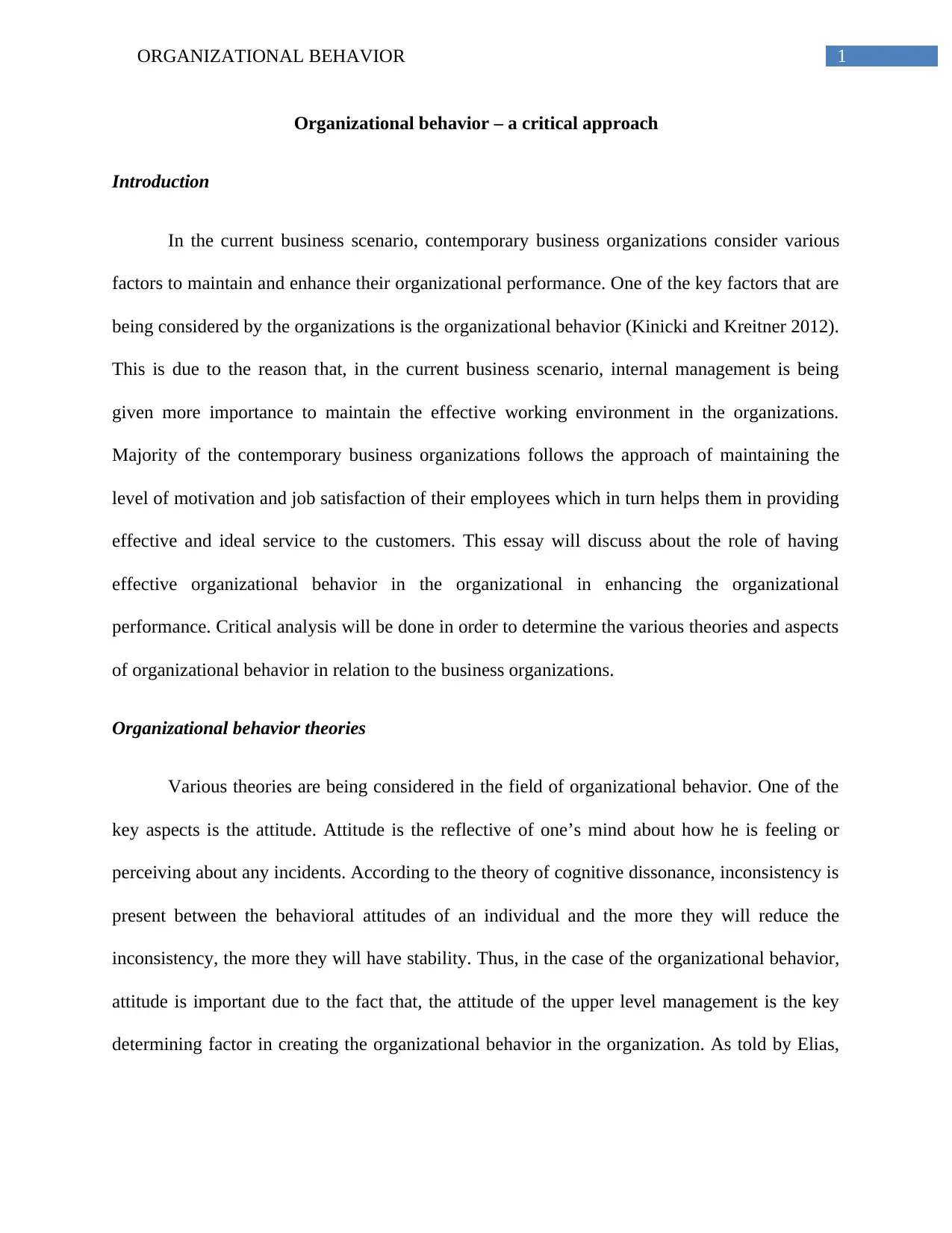
1ORGANIZATIONAL BEHAVIOR
Organizational behavior – a critical approach
Introduction
In the current business scenario, contemporary business organizations consider various
factors to maintain and enhance their organizational performance. One of the key factors that are
being considered by the organizations is the organizational behavior (Kinicki and Kreitner 2012).
This is due to the reason that, in the current business scenario, internal management is being
given more importance to maintain the effective working environment in the organizations.
Majority of the contemporary business organizations follows the approach of maintaining the
level of motivation and job satisfaction of their employees which in turn helps them in providing
effective and ideal service to the customers. This essay will discuss about the role of having
effective organizational behavior in the organizational in enhancing the organizational
performance. Critical analysis will be done in order to determine the various theories and aspects
of organizational behavior in relation to the business organizations.
Organizational behavior theories
Various theories are being considered in the field of organizational behavior. One of the
key aspects is the attitude. Attitude is the reflective of one’s mind about how he is feeling or
perceiving about any incidents. According to the theory of cognitive dissonance, inconsistency is
present between the behavioral attitudes of an individual and the more they will reduce the
inconsistency, the more they will have stability. Thus, in the case of the organizational behavior,
attitude is important due to the fact that, the attitude of the upper level management is the key
determining factor in creating the organizational behavior in the organization. As told by Elias,
Organizational behavior – a critical approach
Introduction
In the current business scenario, contemporary business organizations consider various
factors to maintain and enhance their organizational performance. One of the key factors that are
being considered by the organizations is the organizational behavior (Kinicki and Kreitner 2012).
This is due to the reason that, in the current business scenario, internal management is being
given more importance to maintain the effective working environment in the organizations.
Majority of the contemporary business organizations follows the approach of maintaining the
level of motivation and job satisfaction of their employees which in turn helps them in providing
effective and ideal service to the customers. This essay will discuss about the role of having
effective organizational behavior in the organizational in enhancing the organizational
performance. Critical analysis will be done in order to determine the various theories and aspects
of organizational behavior in relation to the business organizations.
Organizational behavior theories
Various theories are being considered in the field of organizational behavior. One of the
key aspects is the attitude. Attitude is the reflective of one’s mind about how he is feeling or
perceiving about any incidents. According to the theory of cognitive dissonance, inconsistency is
present between the behavioral attitudes of an individual and the more they will reduce the
inconsistency, the more they will have stability. Thus, in the case of the organizational behavior,
attitude is important due to the fact that, the attitude of the upper level management is the key
determining factor in creating the organizational behavior in the organization. As told by Elias,
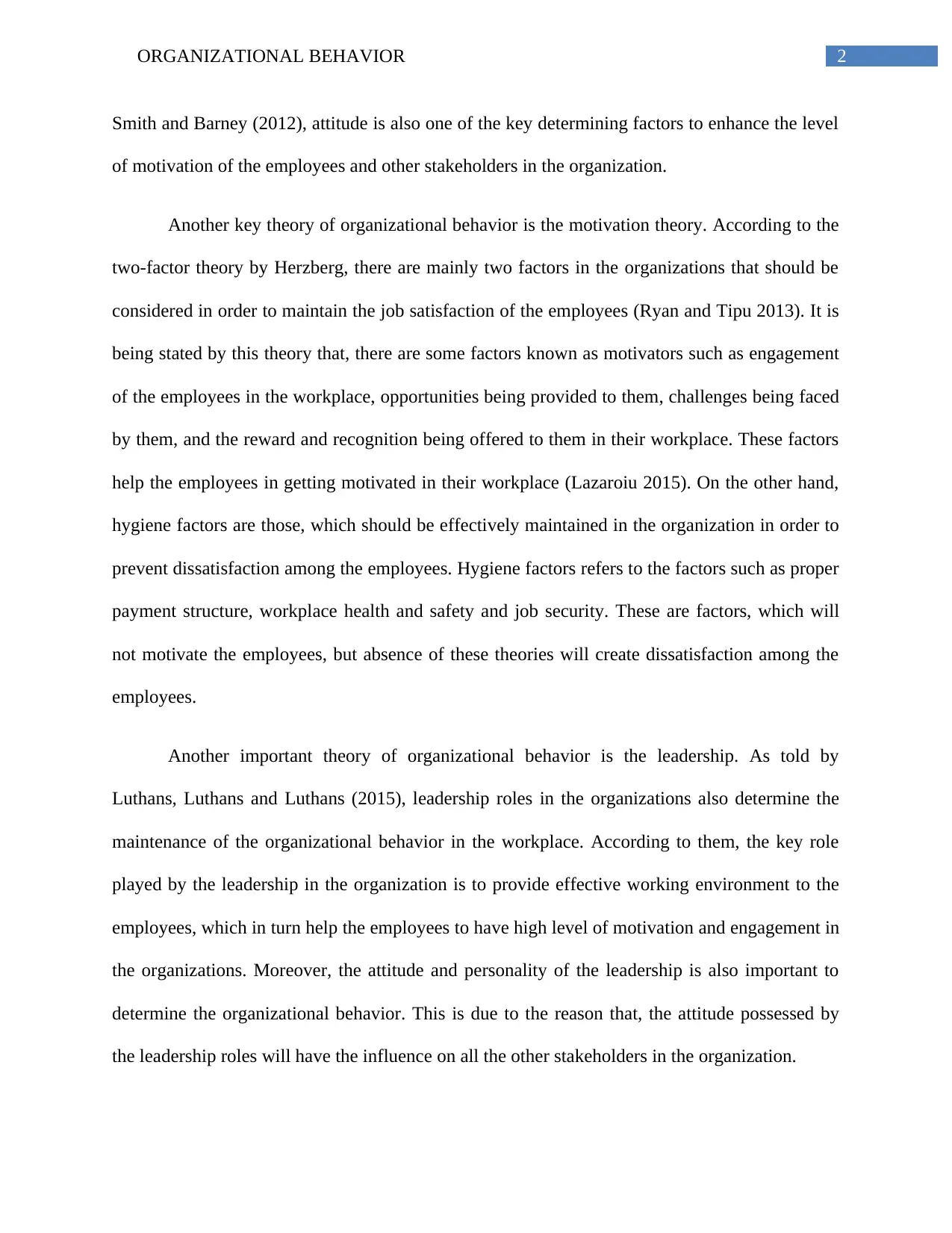
2ORGANIZATIONAL BEHAVIOR
Smith and Barney (2012), attitude is also one of the key determining factors to enhance the level
of motivation of the employees and other stakeholders in the organization.
Another key theory of organizational behavior is the motivation theory. According to the
two-factor theory by Herzberg, there are mainly two factors in the organizations that should be
considered in order to maintain the job satisfaction of the employees (Ryan and Tipu 2013). It is
being stated by this theory that, there are some factors known as motivators such as engagement
of the employees in the workplace, opportunities being provided to them, challenges being faced
by them, and the reward and recognition being offered to them in their workplace. These factors
help the employees in getting motivated in their workplace (Lazaroiu 2015). On the other hand,
hygiene factors are those, which should be effectively maintained in the organization in order to
prevent dissatisfaction among the employees. Hygiene factors refers to the factors such as proper
payment structure, workplace health and safety and job security. These are factors, which will
not motivate the employees, but absence of these theories will create dissatisfaction among the
employees.
Another important theory of organizational behavior is the leadership. As told by
Luthans, Luthans and Luthans (2015), leadership roles in the organizations also determine the
maintenance of the organizational behavior in the workplace. According to them, the key role
played by the leadership in the organization is to provide effective working environment to the
employees, which in turn help the employees to have high level of motivation and engagement in
the organizations. Moreover, the attitude and personality of the leadership is also important to
determine the organizational behavior. This is due to the reason that, the attitude possessed by
the leadership roles will have the influence on all the other stakeholders in the organization.
Smith and Barney (2012), attitude is also one of the key determining factors to enhance the level
of motivation of the employees and other stakeholders in the organization.
Another key theory of organizational behavior is the motivation theory. According to the
two-factor theory by Herzberg, there are mainly two factors in the organizations that should be
considered in order to maintain the job satisfaction of the employees (Ryan and Tipu 2013). It is
being stated by this theory that, there are some factors known as motivators such as engagement
of the employees in the workplace, opportunities being provided to them, challenges being faced
by them, and the reward and recognition being offered to them in their workplace. These factors
help the employees in getting motivated in their workplace (Lazaroiu 2015). On the other hand,
hygiene factors are those, which should be effectively maintained in the organization in order to
prevent dissatisfaction among the employees. Hygiene factors refers to the factors such as proper
payment structure, workplace health and safety and job security. These are factors, which will
not motivate the employees, but absence of these theories will create dissatisfaction among the
employees.
Another important theory of organizational behavior is the leadership. As told by
Luthans, Luthans and Luthans (2015), leadership roles in the organizations also determine the
maintenance of the organizational behavior in the workplace. According to them, the key role
played by the leadership in the organization is to provide effective working environment to the
employees, which in turn help the employees to have high level of motivation and engagement in
the organizations. Moreover, the attitude and personality of the leadership is also important to
determine the organizational behavior. This is due to the reason that, the attitude possessed by
the leadership roles will have the influence on all the other stakeholders in the organization.
⊘ This is a preview!⊘
Do you want full access?
Subscribe today to unlock all pages.

Trusted by 1+ million students worldwide
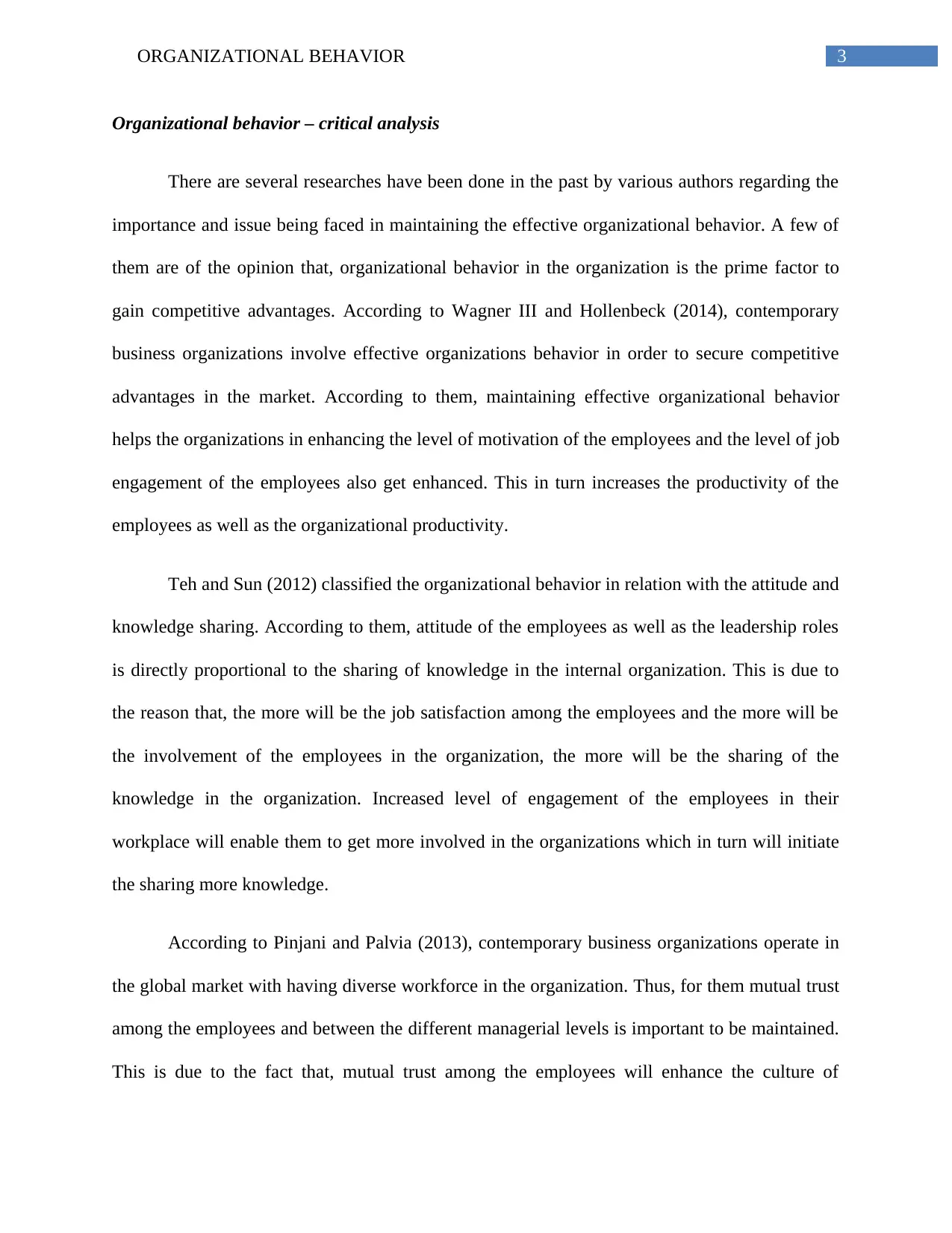
3ORGANIZATIONAL BEHAVIOR
Organizational behavior – critical analysis
There are several researches have been done in the past by various authors regarding the
importance and issue being faced in maintaining the effective organizational behavior. A few of
them are of the opinion that, organizational behavior in the organization is the prime factor to
gain competitive advantages. According to Wagner III and Hollenbeck (2014), contemporary
business organizations involve effective organizations behavior in order to secure competitive
advantages in the market. According to them, maintaining effective organizational behavior
helps the organizations in enhancing the level of motivation of the employees and the level of job
engagement of the employees also get enhanced. This in turn increases the productivity of the
employees as well as the organizational productivity.
Teh and Sun (2012) classified the organizational behavior in relation with the attitude and
knowledge sharing. According to them, attitude of the employees as well as the leadership roles
is directly proportional to the sharing of knowledge in the internal organization. This is due to
the reason that, the more will be the job satisfaction among the employees and the more will be
the involvement of the employees in the organization, the more will be the sharing of the
knowledge in the organization. Increased level of engagement of the employees in their
workplace will enable them to get more involved in the organizations which in turn will initiate
the sharing more knowledge.
According to Pinjani and Palvia (2013), contemporary business organizations operate in
the global market with having diverse workforce in the organization. Thus, for them mutual trust
among the employees and between the different managerial levels is important to be maintained.
This is due to the fact that, mutual trust among the employees will enhance the culture of
Organizational behavior – critical analysis
There are several researches have been done in the past by various authors regarding the
importance and issue being faced in maintaining the effective organizational behavior. A few of
them are of the opinion that, organizational behavior in the organization is the prime factor to
gain competitive advantages. According to Wagner III and Hollenbeck (2014), contemporary
business organizations involve effective organizations behavior in order to secure competitive
advantages in the market. According to them, maintaining effective organizational behavior
helps the organizations in enhancing the level of motivation of the employees and the level of job
engagement of the employees also get enhanced. This in turn increases the productivity of the
employees as well as the organizational productivity.
Teh and Sun (2012) classified the organizational behavior in relation with the attitude and
knowledge sharing. According to them, attitude of the employees as well as the leadership roles
is directly proportional to the sharing of knowledge in the internal organization. This is due to
the reason that, the more will be the job satisfaction among the employees and the more will be
the involvement of the employees in the organization, the more will be the sharing of the
knowledge in the organization. Increased level of engagement of the employees in their
workplace will enable them to get more involved in the organizations which in turn will initiate
the sharing more knowledge.
According to Pinjani and Palvia (2013), contemporary business organizations operate in
the global market with having diverse workforce in the organization. Thus, for them mutual trust
among the employees and between the different managerial levels is important to be maintained.
This is due to the fact that, mutual trust among the employees will enhance the culture of
Paraphrase This Document
Need a fresh take? Get an instant paraphrase of this document with our AI Paraphraser
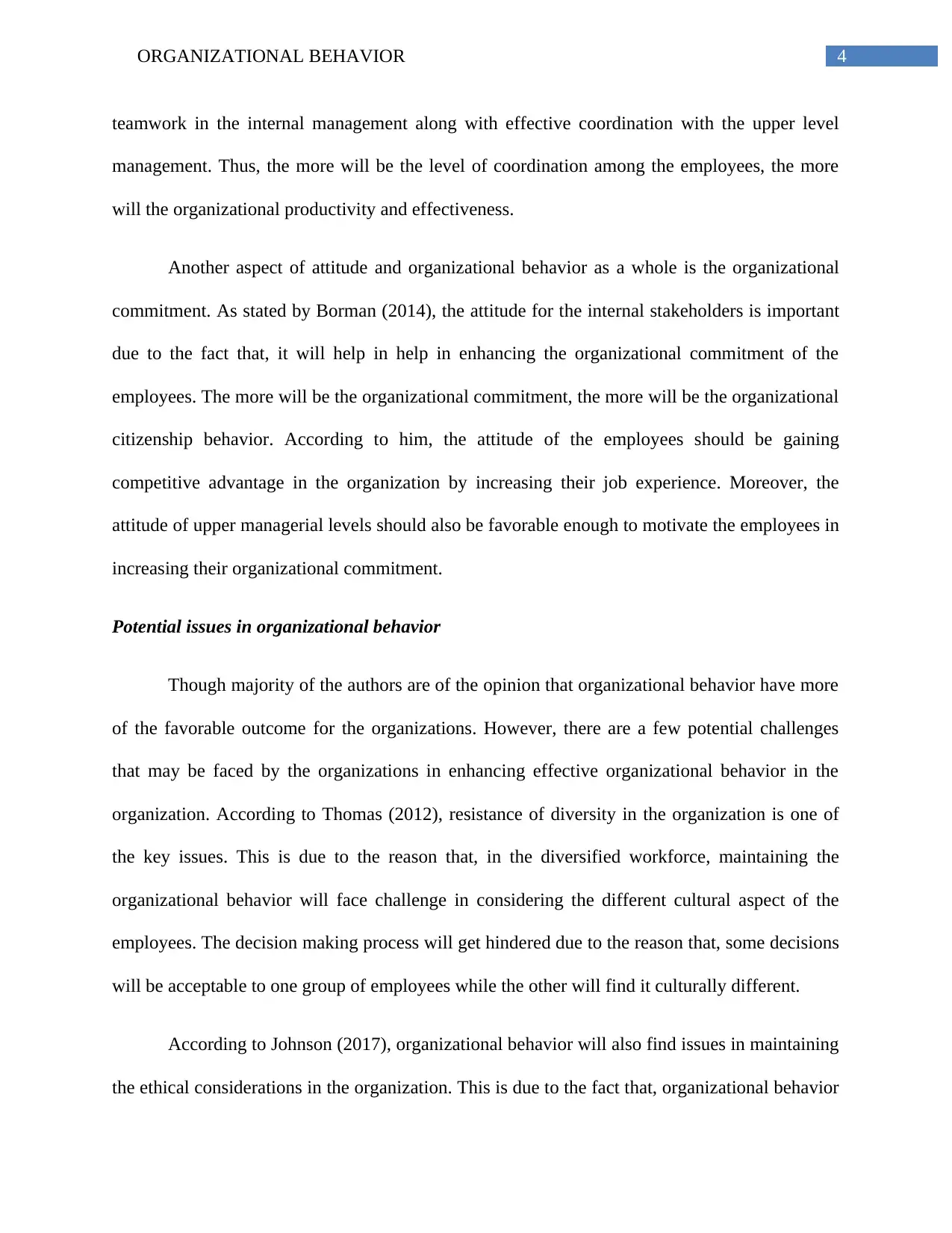
4ORGANIZATIONAL BEHAVIOR
teamwork in the internal management along with effective coordination with the upper level
management. Thus, the more will be the level of coordination among the employees, the more
will the organizational productivity and effectiveness.
Another aspect of attitude and organizational behavior as a whole is the organizational
commitment. As stated by Borman (2014), the attitude for the internal stakeholders is important
due to the fact that, it will help in help in enhancing the organizational commitment of the
employees. The more will be the organizational commitment, the more will be the organizational
citizenship behavior. According to him, the attitude of the employees should be gaining
competitive advantage in the organization by increasing their job experience. Moreover, the
attitude of upper managerial levels should also be favorable enough to motivate the employees in
increasing their organizational commitment.
Potential issues in organizational behavior
Though majority of the authors are of the opinion that organizational behavior have more
of the favorable outcome for the organizations. However, there are a few potential challenges
that may be faced by the organizations in enhancing effective organizational behavior in the
organization. According to Thomas (2012), resistance of diversity in the organization is one of
the key issues. This is due to the reason that, in the diversified workforce, maintaining the
organizational behavior will face challenge in considering the different cultural aspect of the
employees. The decision making process will get hindered due to the reason that, some decisions
will be acceptable to one group of employees while the other will find it culturally different.
According to Johnson (2017), organizational behavior will also find issues in maintaining
the ethical considerations in the organization. This is due to the fact that, organizational behavior
teamwork in the internal management along with effective coordination with the upper level
management. Thus, the more will be the level of coordination among the employees, the more
will the organizational productivity and effectiveness.
Another aspect of attitude and organizational behavior as a whole is the organizational
commitment. As stated by Borman (2014), the attitude for the internal stakeholders is important
due to the fact that, it will help in help in enhancing the organizational commitment of the
employees. The more will be the organizational commitment, the more will be the organizational
citizenship behavior. According to him, the attitude of the employees should be gaining
competitive advantage in the organization by increasing their job experience. Moreover, the
attitude of upper managerial levels should also be favorable enough to motivate the employees in
increasing their organizational commitment.
Potential issues in organizational behavior
Though majority of the authors are of the opinion that organizational behavior have more
of the favorable outcome for the organizations. However, there are a few potential challenges
that may be faced by the organizations in enhancing effective organizational behavior in the
organization. According to Thomas (2012), resistance of diversity in the organization is one of
the key issues. This is due to the reason that, in the diversified workforce, maintaining the
organizational behavior will face challenge in considering the different cultural aspect of the
employees. The decision making process will get hindered due to the reason that, some decisions
will be acceptable to one group of employees while the other will find it culturally different.
According to Johnson (2017), organizational behavior will also find issues in maintaining
the ethical considerations in the organization. This is due to the fact that, organizational behavior
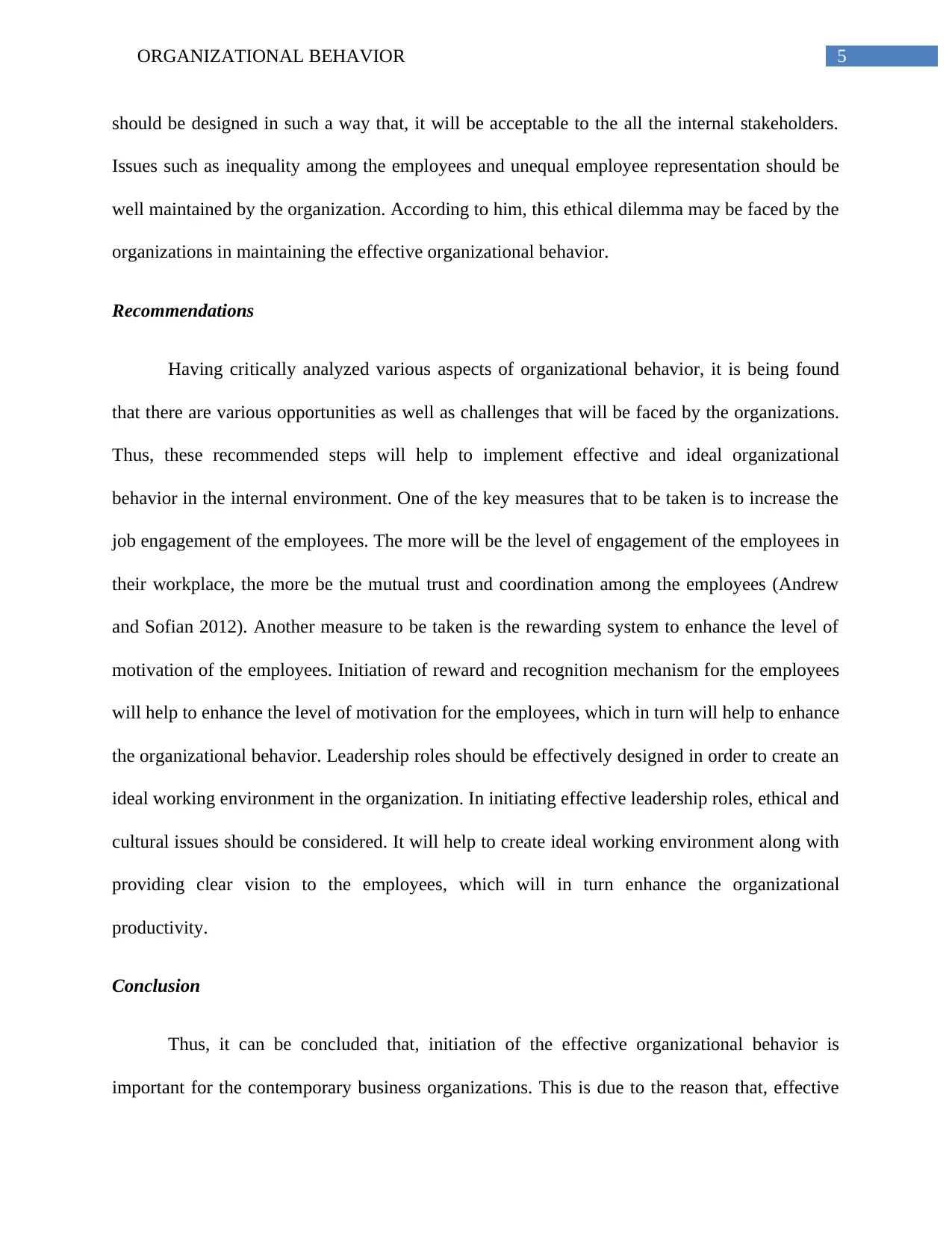
5ORGANIZATIONAL BEHAVIOR
should be designed in such a way that, it will be acceptable to the all the internal stakeholders.
Issues such as inequality among the employees and unequal employee representation should be
well maintained by the organization. According to him, this ethical dilemma may be faced by the
organizations in maintaining the effective organizational behavior.
Recommendations
Having critically analyzed various aspects of organizational behavior, it is being found
that there are various opportunities as well as challenges that will be faced by the organizations.
Thus, these recommended steps will help to implement effective and ideal organizational
behavior in the internal environment. One of the key measures that to be taken is to increase the
job engagement of the employees. The more will be the level of engagement of the employees in
their workplace, the more be the mutual trust and coordination among the employees (Andrew
and Sofian 2012). Another measure to be taken is the rewarding system to enhance the level of
motivation of the employees. Initiation of reward and recognition mechanism for the employees
will help to enhance the level of motivation for the employees, which in turn will help to enhance
the organizational behavior. Leadership roles should be effectively designed in order to create an
ideal working environment in the organization. In initiating effective leadership roles, ethical and
cultural issues should be considered. It will help to create ideal working environment along with
providing clear vision to the employees, which will in turn enhance the organizational
productivity.
Conclusion
Thus, it can be concluded that, initiation of the effective organizational behavior is
important for the contemporary business organizations. This is due to the reason that, effective
should be designed in such a way that, it will be acceptable to the all the internal stakeholders.
Issues such as inequality among the employees and unequal employee representation should be
well maintained by the organization. According to him, this ethical dilemma may be faced by the
organizations in maintaining the effective organizational behavior.
Recommendations
Having critically analyzed various aspects of organizational behavior, it is being found
that there are various opportunities as well as challenges that will be faced by the organizations.
Thus, these recommended steps will help to implement effective and ideal organizational
behavior in the internal environment. One of the key measures that to be taken is to increase the
job engagement of the employees. The more will be the level of engagement of the employees in
their workplace, the more be the mutual trust and coordination among the employees (Andrew
and Sofian 2012). Another measure to be taken is the rewarding system to enhance the level of
motivation of the employees. Initiation of reward and recognition mechanism for the employees
will help to enhance the level of motivation for the employees, which in turn will help to enhance
the organizational behavior. Leadership roles should be effectively designed in order to create an
ideal working environment in the organization. In initiating effective leadership roles, ethical and
cultural issues should be considered. It will help to create ideal working environment along with
providing clear vision to the employees, which will in turn enhance the organizational
productivity.
Conclusion
Thus, it can be concluded that, initiation of the effective organizational behavior is
important for the contemporary business organizations. This is due to the reason that, effective
⊘ This is a preview!⊘
Do you want full access?
Subscribe today to unlock all pages.

Trusted by 1+ million students worldwide
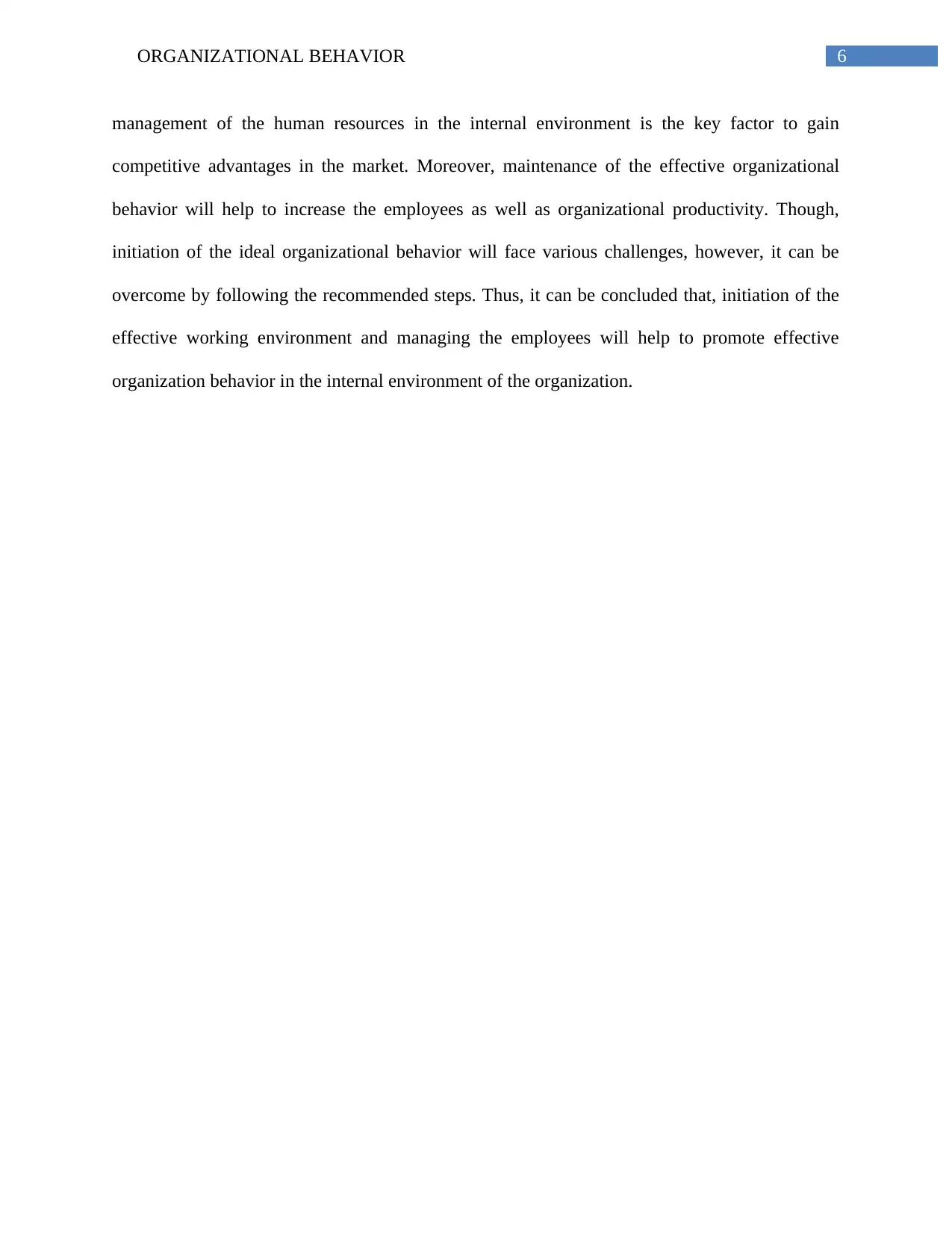
6ORGANIZATIONAL BEHAVIOR
management of the human resources in the internal environment is the key factor to gain
competitive advantages in the market. Moreover, maintenance of the effective organizational
behavior will help to increase the employees as well as organizational productivity. Though,
initiation of the ideal organizational behavior will face various challenges, however, it can be
overcome by following the recommended steps. Thus, it can be concluded that, initiation of the
effective working environment and managing the employees will help to promote effective
organization behavior in the internal environment of the organization.
management of the human resources in the internal environment is the key factor to gain
competitive advantages in the market. Moreover, maintenance of the effective organizational
behavior will help to increase the employees as well as organizational productivity. Though,
initiation of the ideal organizational behavior will face various challenges, however, it can be
overcome by following the recommended steps. Thus, it can be concluded that, initiation of the
effective working environment and managing the employees will help to promote effective
organization behavior in the internal environment of the organization.
Paraphrase This Document
Need a fresh take? Get an instant paraphrase of this document with our AI Paraphraser
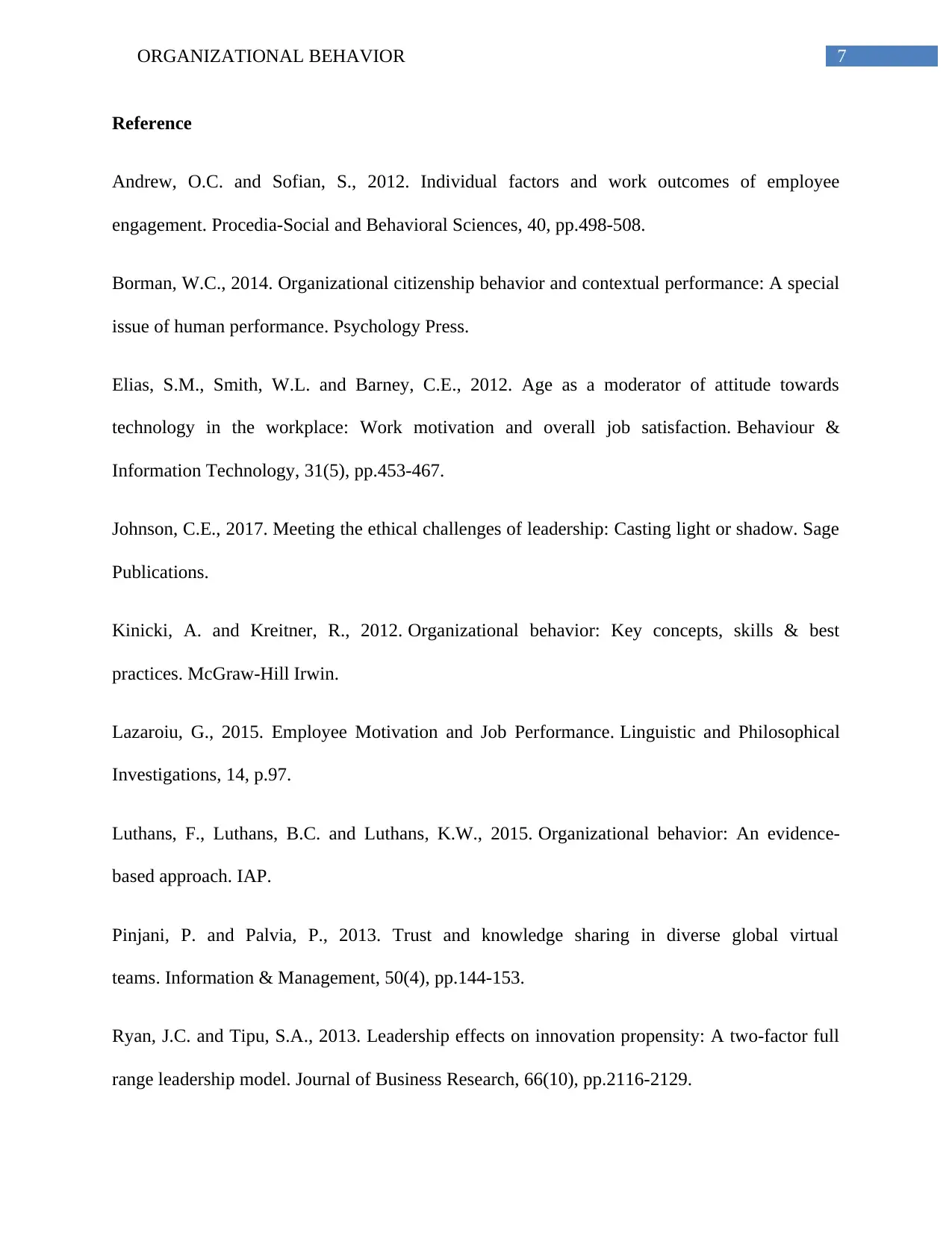
7ORGANIZATIONAL BEHAVIOR
Reference
Andrew, O.C. and Sofian, S., 2012. Individual factors and work outcomes of employee
engagement. Procedia-Social and Behavioral Sciences, 40, pp.498-508.
Borman, W.C., 2014. Organizational citizenship behavior and contextual performance: A special
issue of human performance. Psychology Press.
Elias, S.M., Smith, W.L. and Barney, C.E., 2012. Age as a moderator of attitude towards
technology in the workplace: Work motivation and overall job satisfaction. Behaviour &
Information Technology, 31(5), pp.453-467.
Johnson, C.E., 2017. Meeting the ethical challenges of leadership: Casting light or shadow. Sage
Publications.
Kinicki, A. and Kreitner, R., 2012. Organizational behavior: Key concepts, skills & best
practices. McGraw-Hill Irwin.
Lazaroiu, G., 2015. Employee Motivation and Job Performance. Linguistic and Philosophical
Investigations, 14, p.97.
Luthans, F., Luthans, B.C. and Luthans, K.W., 2015. Organizational behavior: An evidence-
based approach. IAP.
Pinjani, P. and Palvia, P., 2013. Trust and knowledge sharing in diverse global virtual
teams. Information & Management, 50(4), pp.144-153.
Ryan, J.C. and Tipu, S.A., 2013. Leadership effects on innovation propensity: A two-factor full
range leadership model. Journal of Business Research, 66(10), pp.2116-2129.
Reference
Andrew, O.C. and Sofian, S., 2012. Individual factors and work outcomes of employee
engagement. Procedia-Social and Behavioral Sciences, 40, pp.498-508.
Borman, W.C., 2014. Organizational citizenship behavior and contextual performance: A special
issue of human performance. Psychology Press.
Elias, S.M., Smith, W.L. and Barney, C.E., 2012. Age as a moderator of attitude towards
technology in the workplace: Work motivation and overall job satisfaction. Behaviour &
Information Technology, 31(5), pp.453-467.
Johnson, C.E., 2017. Meeting the ethical challenges of leadership: Casting light or shadow. Sage
Publications.
Kinicki, A. and Kreitner, R., 2012. Organizational behavior: Key concepts, skills & best
practices. McGraw-Hill Irwin.
Lazaroiu, G., 2015. Employee Motivation and Job Performance. Linguistic and Philosophical
Investigations, 14, p.97.
Luthans, F., Luthans, B.C. and Luthans, K.W., 2015. Organizational behavior: An evidence-
based approach. IAP.
Pinjani, P. and Palvia, P., 2013. Trust and knowledge sharing in diverse global virtual
teams. Information & Management, 50(4), pp.144-153.
Ryan, J.C. and Tipu, S.A., 2013. Leadership effects on innovation propensity: A two-factor full
range leadership model. Journal of Business Research, 66(10), pp.2116-2129.
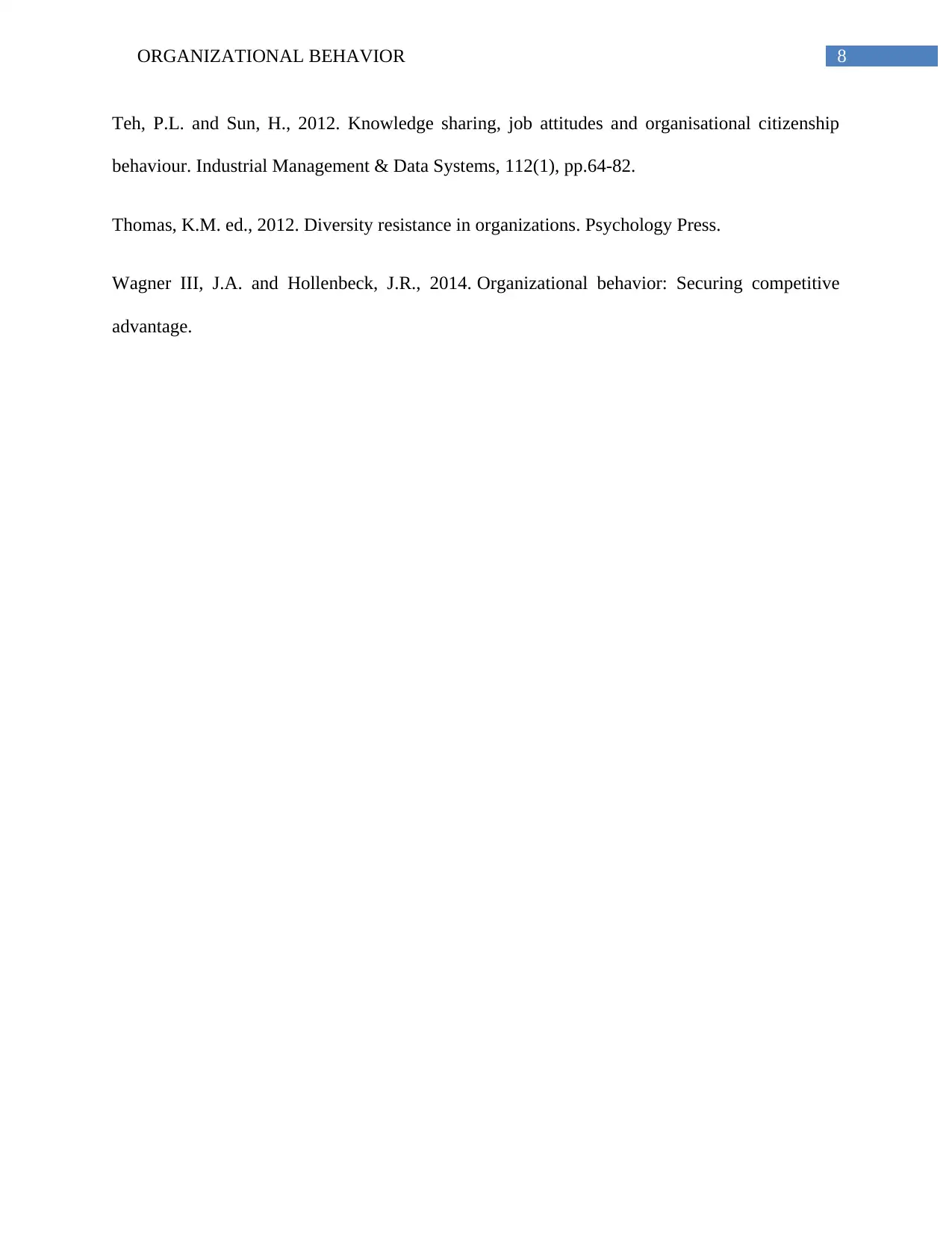
8ORGANIZATIONAL BEHAVIOR
Teh, P.L. and Sun, H., 2012. Knowledge sharing, job attitudes and organisational citizenship
behaviour. Industrial Management & Data Systems, 112(1), pp.64-82.
Thomas, K.M. ed., 2012. Diversity resistance in organizations. Psychology Press.
Wagner III, J.A. and Hollenbeck, J.R., 2014. Organizational behavior: Securing competitive
advantage.
Teh, P.L. and Sun, H., 2012. Knowledge sharing, job attitudes and organisational citizenship
behaviour. Industrial Management & Data Systems, 112(1), pp.64-82.
Thomas, K.M. ed., 2012. Diversity resistance in organizations. Psychology Press.
Wagner III, J.A. and Hollenbeck, J.R., 2014. Organizational behavior: Securing competitive
advantage.
⊘ This is a preview!⊘
Do you want full access?
Subscribe today to unlock all pages.

Trusted by 1+ million students worldwide
1 out of 9
Related Documents
Your All-in-One AI-Powered Toolkit for Academic Success.
+13062052269
info@desklib.com
Available 24*7 on WhatsApp / Email
![[object Object]](/_next/static/media/star-bottom.7253800d.svg)
Unlock your academic potential
Copyright © 2020–2025 A2Z Services. All Rights Reserved. Developed and managed by ZUCOL.





